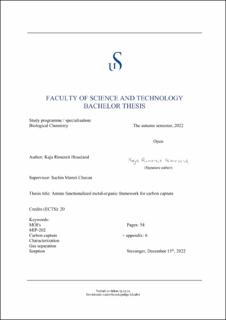| dc.description.abstract | This thesis was all about synthesizing metal-organic frameworks, MOFs, with different compositions, and further on characterize and analyze the products using different measurements. The idea was to find out how we could make the most efficient MOF, with the main goal to capture carbon dioxide. The central emphasis was always using green, non-toxic chemicals, to keep the focus on sustainable energy and the environment. This was fulfilled by using only green solvents, and amino acids. In this work, there has mainly been used D-isomer, L-isomer, and a racemic mixture of these isomers.
MIP-202 samples were synthesized using both reflux with continually stirring below 120°C with different reaction times (1h vs 72h), dissimilar washing procedures and changing the heat parameter using autoclave for 120°C and 140°C. It showed huge differences in the analysis between the different reaction time, and it seems like 72 hours is the optimal time to produce a MOF which is stable and porous. There were surprisingly changes in nitrogen and carbon dioxide sorption for 72h synthesis products compared to the 1h synthesis and could also see a significant better uptake for those 72h samples washed with ethanol for three days. The DL-Aspartic acid with no treatment was calculated to have a specific surface area of 164 m2 g-1, with a total pore volume of 0,093 cm3 g-1. While the same product washed with ethanol for three days showed outstanding porosity with a surface area of 565 m2 g-1 and total pore volume of 0,268 cm3 g-1.
Many of the samples made, showed some good PXRD results, forming a MOF structure. However, the question along the way, was always how to improve the products to become even better. One of the issues was that chlorine got attached to some of the MOFs. Because of the harm to the environment chlorine can make when reacting with other chemicals, we tried to get rid of this. One of the experiments was to wash the MIP-202 with sodium acetate, but unfortunately the MOFs structure got destroyed. What could possibly be the reason for this, was that the chlorine attached to the MOFs containing zirconium and aspartic acid, are necessary for the MOF structure to stay stable.
24 different bulk samples were also made using high-throughput synthesis, where DL-Aspartic acid was used as linker, ZrOCl2 * 8H2O or Zr(SO4)2 * 4H2O was the metal source, and different amounts of modulator, using either formic acid or acetic acid. Two of the samples containing sulfate and both zero and 30 equivalent formic acid were analyzed further. The idea was to try make a chlorine free product, switching from ZrCl4 to Zr(SO4)2, but unfortunately the results were not satisfying. | |
